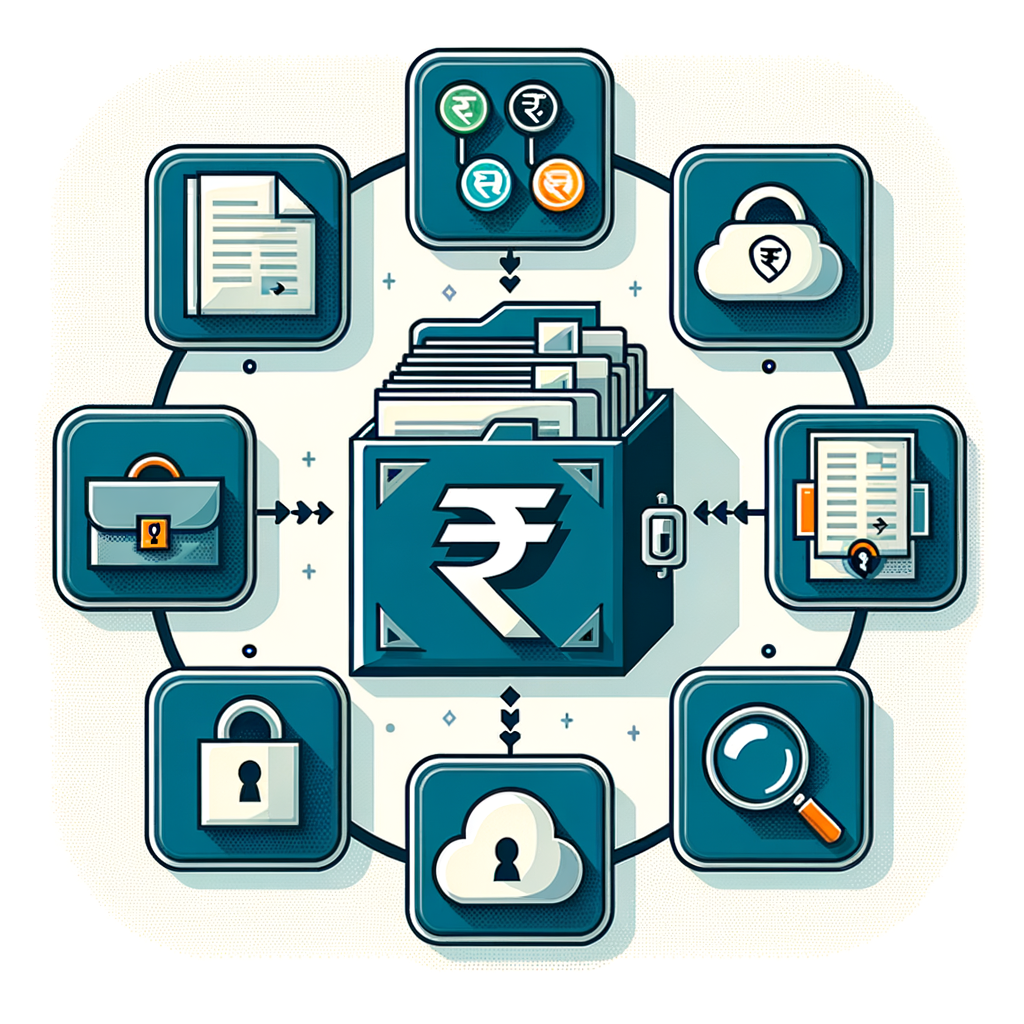How to Organize Your Debt Documentation for Better Management
Is your desk or digital folder cluttered with a growing pile of loan papers, EMI reminders, and credit card statements? For many, this scene is a major source of stress and confusion. The risk of disorganized documents goes beyond simple clutter; it can lead to missed payments, hefty penalty fees, a damaged credit score, and an inability to track your true financial health. This post provides a simple, actionable guide to debt documentation management, tailored specifically for salaried individuals and small business owners in India. By following these steps, you can learn how to manage debt documentation efficiently and finally gain complete control over your finances.
Why Effective Debt Documentation Management is Crucial in India
Having a system in place is not just about being tidy; it’s about smart financial stewardship. Implementing effective debt organization strategies offers tangible benefits that can protect your financial future, whether you’re managing a household budget or running a company. A well-organized system provides clarity, ensures compliance, and empowers you to make better financial decisions. It transforms a chaotic pile of papers into a powerful tool for financial planning and growth.
For Salaried Individuals
For those earning a salary, managing personal debts like home loans, car loans, and credit cards is a monthly reality. Proper organization can make a world of difference.
- Easy Tax Filing: One of the biggest advantages is simplified tax filing. When it’s time to file your returns, you won’t have to frantically search for your home loan interest and principal certificates. With an organized system, you can quickly access these documents to claim valuable tax deductions under Section 80C and Section 24 of the Income Tax Act, maximizing your savings.
- Credit Score Health: Your CIBIL score is your financial reputation. Disorganization often leads to misplaced bills and forgotten due dates, resulting in missed payments. Even a single late payment can negatively impact your credit score, making it harder and more expensive to secure loans in the future. A good system ensures you pay every EMI on time.
- Financial Clarity: When your documents are in order, you can easily see the bigger picture. A quick glance at your records will tell you your total liabilities, the interest rates you’re paying, and how much progress you’ve made on your repayments. This clarity is essential for effective budgeting and long-term financial planning.
For Small Business Owners
For entrepreneurs, the stakes are even higher. Debt, in the form of business loans, working capital facilities, and creditor agreements, is often the lifeblood of a growing enterprise.
- Audit and Compliance: A clean set of records is non-negotiable for seamless audits and regulatory compliance. Whether it’s for GST filings, income tax assessments, or other statutory requirements, organized debt documentation ensures you can produce any required document instantly, avoiding potential penalties and legal complications.
- Future Funding: When your business is ready to expand, you will likely need to apply for new loans or increase existing credit lines. Lenders will scrutinize your financial history. Presenting a clear, well-maintained, and organized record of your existing liabilities demonstrates financial discipline and significantly improves your chances of securing the funding you need.
- Better Negotiations: Knowledge is power. With all your credit terms, repayment schedules, and communication with lenders and suppliers neatly organized, you are in a much stronger position to negotiate. You can leverage this information to discuss better interest rates with lenders or more favorable payment terms with your creditors.
A Step-by-Step Guide to Organize Debt Documents for Better Management
Getting started is the hardest part, but this straightforward framework will help you create a robust system. Think of this as your essential debt management documentation guide India, designed to bring order to financial chaos and put you back in the driver’s seat.
Step 1: Gather Every Debt-Related Document
The first step is to conduct a thorough search and collect every single document related to your debts. Look through your files, email inboxes, and digital folders. Don’t stop until you have everything in one place.
Your document checklist should include:
- Loan Sanction Letters & Original Agreements
- Repayment Schedules (also known as Amortization Schedules)
- Monthly EMI Statements and Payment Receipts
- All Credit Card Statements
- Loan Closure Certificates or No Dues Certificates (NDCs) for paid-off debts
- Any official communication, letters, or emails from your lenders
Step 2: Categorize Your Debts Logically
Once you have all your documents, the next step is to sort them. Piling them all together won’t solve the problem. Create logical categories that make sense for your situation.
Suggested Categories:
- By Type (for Individuals):
- Secured Loans: Create separate folders for your Home Loan, Car Loan, etc.
- Unsecured Loans: Create folders for Personal Loans and each Credit Card.
- By Type (for Businesses):
- Long-Term Loans: For machinery, property, or other major assets.
- Short-Term/Working Capital Loans: For managing daily operations.
- Creditor Payables: Agreements and invoices from your suppliers.
- Pro-Tip: Use physical color-coded folders for different loan types (e.g., green for home loans, blue for car loans) or create clearly named digital sub-folders to keep everything distinct and easy to find.
Step 3: Choose Your Storage System (Physical, Digital, or Hybrid)
Decide where you will store these organized documents. Each system has its own advantages, and the best choice often depends on your comfort level with technology and the nature of the documents.
| System | Pros | Cons |
|---|---|---|
| Physical | Tangible, legally valid originals. No tech failure risk. | Vulnerable to fire, flood, or theft. Difficult to search quickly. |
| Digital | Easily accessible from anywhere. Searchable, and easy to back up. | Requires consistent scanning and naming. Risk of cyber threats. |
| Hybrid | Combines physical security for originals with digital accessibility. | Requires discipline to maintain two systems simultaneously. |
The Hybrid Approach is highly recommended:
- Physical System: Use binders and a secure, lockable file cabinet for legally critical original documents like signed loan agreements and the all-important No Dues Certificates (NDCs).
- Digital System: Use cloud storage like Google Drive or Dropbox for day-to-day management. Scan all physical documents using an app like Adobe Scan. Name your digital files consistently for easy retrieval (e.g.,
HomeLoan_HDFC_Statement_May2024.pdforBusinessLoan_Axis_Agreement_Jan2023.pdf).
Step 4: Create a Master Debt Summary Sheet
This is the most powerful tool in your entire system. A Master Debt Summary Sheet is a single document, like an Excel or Google Sheet, that gives you a complete overview of all your liabilities at a glance.
Create a sheet with the following columns:
| Lender Name | Loan Account Number | Type of Debt | Total Loan Amount | Interest Rate (Fixed/Floating) | EMI Amount | EMI Payment Date | Loan Start & End Date | Outstanding Balance (Updated Quarterly) | Notes / Link to Digital Folder |
|---|---|---|---|---|---|---|---|---|---|
| HDFC Bank | 123456XXXX | Home Loan | ₹50,00,000 | 8.5% (Floating) | ₹43,391 | 5th | Jan 2022 – Jan 2042 | ₹48,50,000 | Link to Folder |
| Bajaj Finserv | 987654XXXX | Personal Loan | ₹5,00,000 | 13% (Fixed) | ₹11,377 | 10th | Mar 2023 – Mar 2028 | ₹4,20,000 | Link to Folder |
| ABC Corp | INV-00123 | Business Creditor | ₹75,000 | N/A | Full Payment | 30th | May 2024 – Jun 2024 | ₹75,000 | Payment due 25/06 |
This sheet becomes your central dashboard for tracking payments, monitoring outstanding balances, and planning your finances.
Best Practices for Ongoing Debt Documentation Management
Creating a system is just the beginning. The key to long-term success is maintenance. Here are some of the most important managing debt documentation tips India to ensure your system remains effective over time.
Schedule Monthly or Quarterly Reviews
Discipline is crucial. Set a recurring reminder in your calendar for the 15th of every month or the first week of every quarter. Use this time to:
- File away new statements and receipts you’ve received.
- Update the “Outstanding Balance” column in your Master Debt Summary Sheet.
- Check for any upcoming payments or important communications from lenders.
Digitize New Documents Immediately
Don’t let new papers pile up. Make it a habit to scan and file any new document—be it a credit card statement or a letter from your bank—as soon as you receive it. This simple habit takes only a few minutes but prevents you from having to do a massive organization project ever again.
Ensure Security and Confidentiality
Your debt documents contain sensitive personal and financial information. Protect them accordingly.
- For Digital Files: Use strong, unique passwords for your cloud storage accounts. Most importantly, enable two-factor authentication (2FA) for an extra layer of security.
- For Physical Files: Store your documents in a secure, lockable cabinet. For irreplaceable documents like NDCs, consider a fireproof and waterproof safe or a bank locker.
Know Document Retention Rules in India
You don’t need to keep every document forever, but some are critical.
- Loan Closure Certificate / No Dues Certificate (NDC): Keep this permanently. It is your absolute proof that you have fully repaid the loan and the lender has no further claim against you.
- Loan Agreements: It is a good practice to keep the original agreement for at least 3-5 years after you have closed the loan.
- Tax-Related Documents: For documents used in tax filings, such as your home loan interest certificate, the Income Tax Department advises keeping records for up to 7-8 years from the end of the relevant assessment year.
- For the most up-to-date regulations on record-keeping, it is always best to refer to the official Income Tax Department of India website.
Conclusion
Taking control of your finances begins with organization. By following the key steps—Gather, Categorize, Store, Summarize, and Maintain—you can transform a source of stress into a system of empowerment. Effective debt documentation management is not just about clean files; it’s about reducing financial anxiety, making smarter decisions, avoiding costly mistakes, and ensuring you are always in a position of strength. This structured approach provides the clarity and confidence needed to navigate your financial journey successfully.
If managing your business or personal finances feels overwhelming, TaxRobo is here to help. Our experts offer comprehensive accounting and financial advisory services to streamline your processes. Contact us today for a consultation!
Frequently Asked Questions (FAQs)
Q1. How long should I keep my loan documents after the loan is fully paid in India?
Answer: You must keep the No Dues Certificate (NDC) or Loan Closure Certificate permanently. It is the ultimate proof of repayment. It is advisable to keep other related documents like the original loan agreement and key statements for at least 3-5 years for your personal records.
Q2. What are the best free digital tools for managing debt documents?
Answer: For most individuals and small businesses, a combination of Google Sheets (for the master summary) and Google Drive or Dropbox (for storing scanned documents) is highly effective, secure, and free to start with.
Q3. Can poor documentation directly impact my CIBIL score?
Answer: Indirectly, yes. While the act of being disorganized doesn’t lower your score, it often leads to missed or delayed EMI payments, which are major factors that negatively impact your CIBIL score. Proper management ensures timely payments and helps protect your credit health.
Q4. Is it safe to store financial documents like loan agreements on the cloud?
Answer: Yes, it is generally safe if you use reputable cloud providers (like Google Drive, Dropbox, or Microsoft OneDrive) and follow security best practices. Always enable two-factor authentication (2FA), use a strong, unique password for your account, and be wary of phishing emails that ask for your login credentials.



